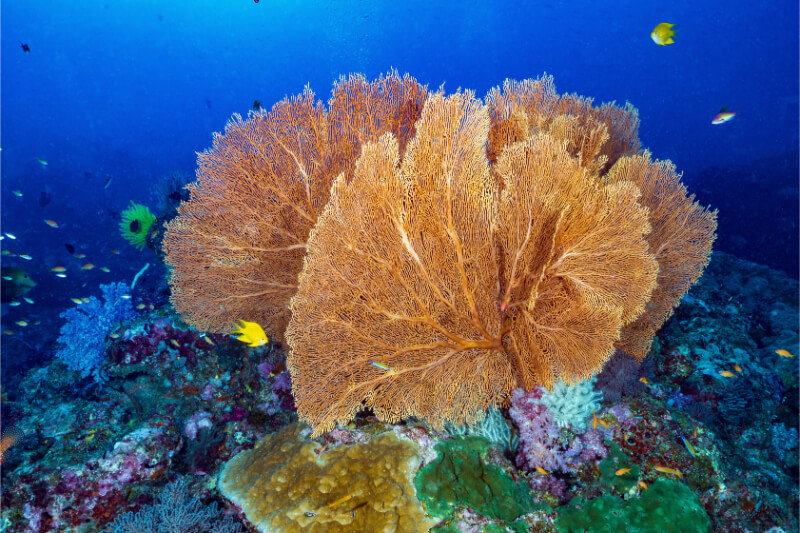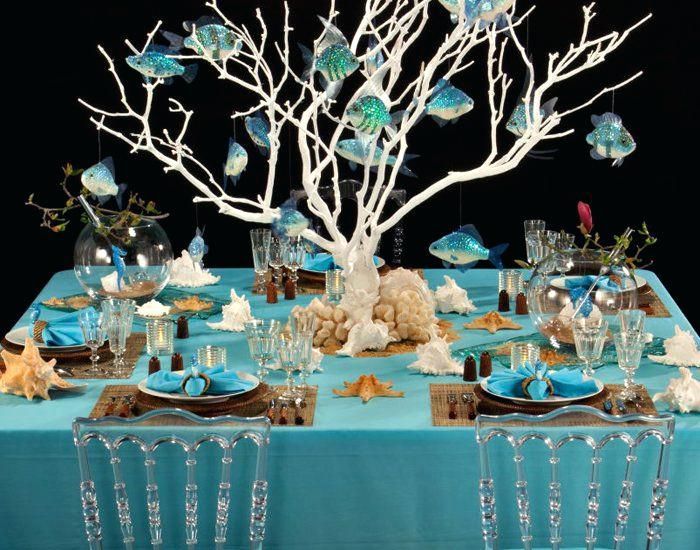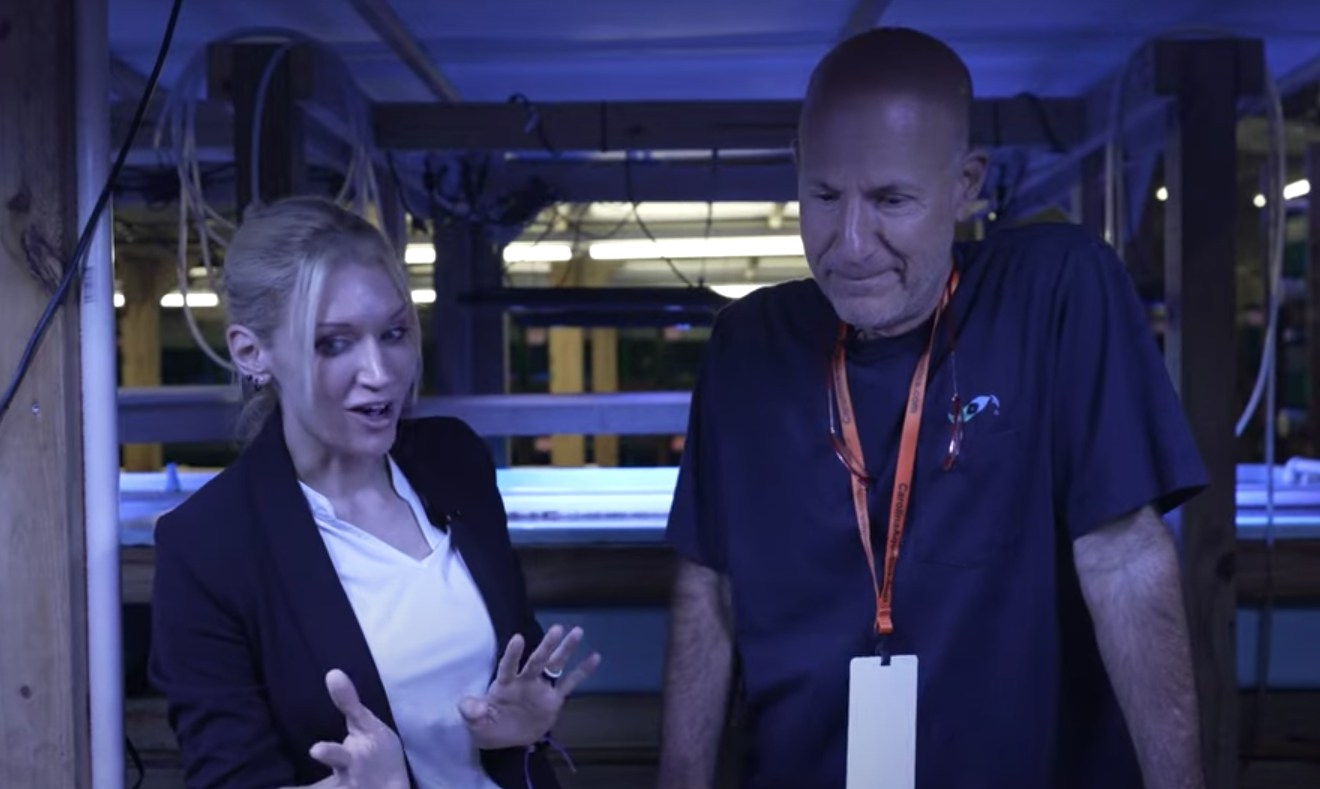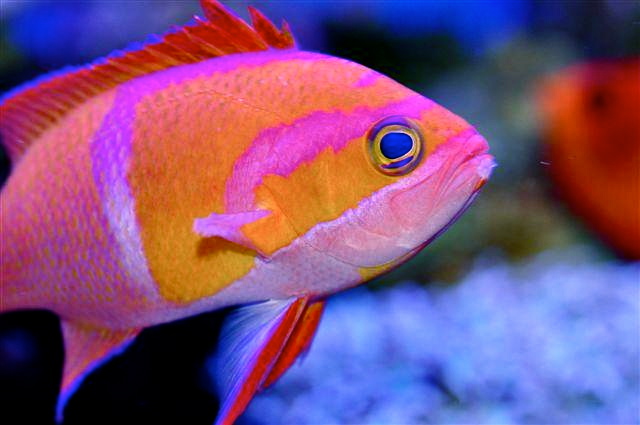Gorgonians are among the best corals you can add to a saltwater aquarium because of their amazing and complex shapes. Let’s be honest, who wouldn’t want a coral that looks like a fan of the sea? So, with some practice and the proper guidance even beginners are able to care for them.
Cool Fact: If you like Greek mythology, then you will be happy to learn that the name of the Gorgonian Coral comes from the word Gorgons which were three female monsters with hair made of venomous snakes, also known as Gorgon Medusa.
These corals are among our favorites so we hope you enjoy learning how to take the best care for your Gorgonian Coral. Let’s dive in!
Quick Facts 
| Scientific Classificaiton: | Kingdom: Animalia. Phylum: Cnidaria. Class: Octocorallia. Order: Alcyonacea |
| Other Names: | Sea Fans, Sea Whips, Horn Coral, Horny Coral |
| Water Flow: | Gentle to moderate, 20 to 40 times water turnover |
| Compatibility: | Clown Goby, Firefish Goby, Lawnmower Blenny, Bumblebee Snail, Harlequin Shrimp |
| Size & Growth: | Growth: .12-.4in/yr. Size: up to 6.5ft |
| Care Level: | Moderate to difficult |
| Feeding: | Marine algae, Zooplankton, Brine shrimp (targeted feeding if possible) |
| Water Parameters: | 72-78 F, 8.1-8.4 pH, 1.024-1.026 SG, Ca 350-450 ppm, MG 1260-1350 ppm, 8-9.5 dKH |
| Tank Size: | 75 gallons |
| Lighting: | 35-50 PAR |
| Propagation & Fragging: | Low difficulty (as long as water paremeters are constant) |
Species Summary
When you’re peering into the depths of the ocean, you might come across the remarkable Gorgonian corals. These creatures are part of the Cnidaria phylum, which also includes animals like jellyfish and sea anemones. You could think of them as the trees of the sea because of their branching structure that resembles a leafless tree.
Here’s what you should know about these sea fans:
- Kingdom: Animalia
- Phylum: Cnidaria
- Class: Octocorallia
- Order: Alcyonacea
Does the Gorgonian have a large scientific family?
Yes! Gorgonian corals are categorized within several families, with the Gorgoniidae family being one prominent example. This family is diverse and can be found in various oceanic environments. Their classification is broken down into suborders like Holaxonia, Scleraxonia, and Calcaxonia, chiefly characterized by differences in their skeletal structures.
These corals play a crucial role in marine ecosystems. They offer protection and habitat for countless marine species. The intricate anatomical designs of Gorgonians are not only key to marine life but also to the allure they hold for divers and ocean enthusiasts.
- Distinctive Structure: The sea fans’ structure allows them to catch plankton and tiny particles from the water for nutrition (this type of feeding is referred to as “passive feeding”).
- Various Habitats: Gorgonian corals can thrive in tropical and subtropical waters but are versatile enough to be found in polar and deep-sea environments as noted on Wikipedia.
Author Note: Remember, while Gorgonians are often called “soft corals,” because they don’t have solid skeletons, they’re quite different from the “true” corals of the Scleractinia order. So next time you’re diving or watching a documentary, keep an eye out for these fascinating structures that add another layer of beauty to the ocean’s blueprint.
Appearance
Have you seen those intricate underwater structures that seem to fan out like colorful trees? Those are Gorgonian Corals, commonly referred to as Sea Fans.
Their appearance is quite unique, with a variety of hues that add a vibrant splash to the ocean’s palette. Imagine – deep sea gardens filled with branching formations where shades of red, yellow, orange, and white intertwine to create stunning visuals.
Gorgonians are known for their branching systems, each flaunting a multitude of small polyps. These polyps aren’t just for show; they play a vital role in the corals’ survival. Picture this: each polyp extends out with eight tentacles, waving about to catch food and to breathe.
Author Note: During the day, you’ll often see them withdrawn into the structure, but at night, the corals come to life as these feathery tentacles reach out into the currents. If you fail to see your Gorgonian coral extend its polyps during the night, it could be indicative that your coral is sick or unhappy with its current conditions.
Here’s a quick glimpse at their fascinating palette:
- Red corals stand out in the deep, where less light penetrates the water.
- Yellow and orange species brighten up shallower areas.
- White varieties provide a stark contrast against the often darker ocean backgrounds.
Corals are often underestimated members of a marine ecosystem. The next time you see one, take a moment to consider its importance to the coral’s surrounding oceanic inhabitants. Indeed, their importance cannot be overstated: they protect coastlines, absorb and store harmful pollutants and act as a source of food and habitat to other marine life.
Popular Gorgonian Coral Species
Among the multitude of marine creatures, gorgonian corals, also known as sea fans or horny corals, are particularly captivating. They are a type of soft coral found mainly in tropical and subtropical waters, exhibiting a branching, tree-like form. Here’s a snapshot of some popular species you might encounter.
- Red Gorgonian (Gorgonia ventalina):
- Nickname: Sea fan
- Habitat: Shallow reefs
- Appearance: Vibrant red with intricate branching
- Purple Sea Rod (Plexaura homomalla):
- Nickname: Sea rod
- Habitat: Deep and shallow reefs
- Appearance: Purplish hue with a more rigid structure
- Yellow Sea Whip (Leptogorgia virgulata):
- Nickname: Sea whip
- Habitat: Depths of up to 40 meters
- Appearance: Yellow or orange, slender with characteristic whip-like branches
- Common Sea Fan (Gorgonia mariae):
- Nickname: Sea fan
- Habitat: Prefer currents in shallow waters
- Appearance: Large, fan-shaped with a range of colors
- Venus Sea Fan (Gorgonia flabellum):
- Nickname: Venus fan
- Habitat: Reef slopes and flats
- Appearance: Delicate, latticed structure, usually purple or brown
What’s your favorite?
Each of these gorgonian coral species contributes uniquely to a reef’s ecosystem. Red gorgonians form dense fans that serve as a shelter for various marine life, while the elegant sea rods sway gently in the current.
The yellow sea whips, often bending with the water’s movement, add a splash of color to the seascape. The common sea fans use their dynamic structures to filter-feed on passing nutrients, and the Venus sea fans decorate the ocean floor with their intricate patterns.
Final Deciding Touch
When choosing which Gorgonian species you’d like in your tank, the deciding factor really comes down to whether your specific coral is photosynthetic or non-photosynthetic, as this dictates where you place the coral and other tank parameters. Outside of this decision, it is perfectly fine to choose your gorgonian based on coloration or shape.
These mesmerizing species are not just an underwater spectacle; they’re part of an intricate marine community.
Gorgonian Coral Care
Creating a hospitable environment for Gorgonian Coral in your reef aquarium involves careful attention to tank size and water parameters, which are critical to mimic their natural habitats ranging from the Pacific to the Atlantic ocean. Let’s dive into this specifics to ensure your Gorgonian thrives.
Tank Size
When it comes to housing Gorgonian Coral, the size of your saltwater aquarium matters. Here’s what you need to consider:
- Minimum Tank Size: For smaller species, a 30-gallon tank may suffice, but larger species flourish in tanks that are 75 gallons or more (check our 75 gallon guide).
- Space: Ensure ample space for growth and water flow, as Gorgonians dislike crowding and require good circulation to deliver nutrients and remove waste. In fact, Gorgonian coral polyps will retract, rather than extend, when they encounter glass, rock, or other obstacles. Since this coral cannot properly feed if its polyps are retracted, ample space is a must!
Water Parameters
No place like home! Gorgonian Corals are found in diverse environments, from the subtropical Bahamas to the Indo-Pacific region, and their care requires precise water parameters:
- Temperature: Aim for a range of 72°F to 78°F (22°C to 26°C) to mimic subtropical to tropical waters.
- pH Level: Keep your water’s pH levels consistent, ideally between 8.1 and 8.4.
- Calcium: Essential for calcification, maintain calcium levels at 350 to 450 ppm.
Remember, stability is key — frequent fluctuations can stress your Gorgonian Coral.
Author Note: Elevated temperature or nutrient pollution can infect your gorgonian with Aspergillosis, a fungal pathogen that can have mild to severe effects on the mortality of your coral.
Regular testing and adjustments help maintain a balanced marine habitat akin to their natural Caribbean or South Atlantic origins.
Tank Setup
When setting up your reef tank for Gorgonian coral, it’s important to consider specific factors such as placement, acclimation, lighting, and water flow to ensure their optimal health and growth.
Placement
Gorgonians thrive when placed in an area of the tank that emulates their natural habitat. Avoid crowded areas where other corals might overshadow them. Instead, opt for a spot with ample space around for adequate water flow and access to light.
Author Note: Ensure that this coral species is securely anchored to rockwork or substrate as they can be quite flexible and may sway in strong currents.
Acclimation
Introducing your Gorgonian coral to the tank should be done gradually. Start with a common process called dipping to cleanse any potential pests and then slowly acclimate your coral to your tank’s water parameters with a drip acclimation process over the course of an hour or two, adjusting the temperature and chemical composition to match your tank.
Lighting
Gorgonian corals have specific lighting needs depending on their type: they are either photosynthetic, or non-photosynthetic. Photosynthetic varieties require moderate to high lighting to thrive (35-50 PAR), while non-photosynthetic species do well in low-light conditions (15-30 PAR).
Author Note: Position photosynthetic Gorgonians higher up in your tank where they can receive plenty of light without being in direct, intense light that could potentially bleach them (a fatal event for corals).
Filtration and Water Flow
Effective filtration is crucial for maintaining water quality, which Gorgonians are particularly sensitive to. Employ a combination of mechanical, chemical, and biological filters to keep water parameters stable.
For the ideal flow, aim for a gentle to moderate, turbulent flow that mimics the ocean’s currents. Usually, a water turnover of 20 to 40 times works fine. This turnover rate ensures proper nutrient delivery and waste removal without damaging the coral’s delicate structure.

Growth Rate and Size
When you’re exploring the intricate world of gorgonian corals, understanding their growth patterns can be fascinating. Gorgonian corals, which you might know as sea fans or sea whips, grow at a pace that is directly influenced by their environment and species. Typically, their growth rate varies.
How fast do they grow? Deep-water gorgonians, for example, exhibit different growth rates than those at more shallow depths. Bamboo corals, part of the gorgonian family, can grow axially at a rate of 0.3-1 cm per year. It’s the gorgonin, a type of collagen that forms their anatomical core, which allows these corals to develop their characteristic flexible, tree-like structures.
Gorgonians also have a rind—a protective outer layer—that contributes to their overall size and shape. The largest known fragments of certain upright gorgonian corals can reach heights of nearly two meters or 6.5 feet! Imagine that towering from the seafloor it’s anchored to!.
Here’s a quick glance at typical growth metrics of these beautiful sea structures:
| Feature | Typical Growth Measurement |
| Radial Growth | 20-215 µm/year |
| Axial Growth | 0.3-1 cm/year |
| Maximum Height | Up to approximately 197.5 cm |
Feeding
Feeding your Gorgonian corals can be a fun and rewarding part of your aquarium hobby. These stunning creatures do well with a diet that includes marine algae and various types of plankton.
- Zooplankton: Your Gorgonians will thank you for these tiny organisms, which they can capture with their polyps. Zooplankton provide important nutrients for corals, including proteins, lipids and carbohydrates (targeted feeding is a good way to optimize their feeding).
- Brine shrimp: Occasionally, you can treat your corals to brine shrimp, which can benefit your coral’s growth and color.
To keep your Gorgonians in top shape, try to mimic their natural diet as much as possible. Your corals will absorb glucose and amino acids directly from the water, important for their growth and sustenance. It’s also beneficial to provide a mix of:
- Copepods: These are a favorite among Gorgonian corals and are found in natural coral reefs too.
- Marine algae: This is a great indirect food source as it sustains many of the smaller creatures your corals will munch on.
If you’re keen on seeing your Gorgonians thrive, consider feeding them with a specially designed coral food that supports their continuous feeding habits.
Author Note: Feeding your coral excessive amounts of food may lead to high nutrient levels that could harm your tank’s ecosystem.
It’s all about balance, and your Gorgonians will show their appreciation through vibrant colors and growth. Enjoy the process, and watch them flourish!
Compatibility
When setting up your tank, ensuring a harmonious environment for your Gorgonian coral is key. Your coral’s well-being depends on the friends and foes among their tank mates.
Friendly Tank Mates:
Unsuitable Companions:
- Aggressive Fish: Avoid species known to be coral-eaters or those with a tendency to pick at the coral structure. The French Angelfish develops a taste for corals as adults. Some wrasses like the Red Coris Wrasse are also not recommended because of its rock-flipping behavior that could damage your coral. Lastly, the Dog-Faced Puffer and other similar fish tend to nibble at and potentially consume some invertebrates and coral.
- Certain nudibranchs: These could harm your Gorgonian by feeding on them.
Spatial Considerations:
- Distance: Provide at least 6 inches of space between corals to avoid competition for nutrients and light.
- Room to Grow: Gorgonians should have enough space to grow without encroaching on other tank inhabitants.
Keep these tips in mind, and you’re more likely to have a thriving Gorgonian coral in your home aquarium.
Propagation and Fragging
When you jump into gorgonian coral propagation, you’re diving (pun intended) into a fascinating aspect of coral care. The process, known as fragging, is a form of asexual reproduction that can be done within the comfort of your home aquarium. Here’s your guide to getting it right:
Understanding Fragging Basics
- Frag: A piece cut from the parent coral
- Propagation: The process of growing new corals from frags
Fragging Steps
- Choose a healthy part of your gorgonian that’s likely to survive the process.
- Using a clean, sharp instrument (such as a bone knife), make a careful cut to create a frag.
- Place the frag in a pre-drilled plug or on a small, reef-safe rock.
- Allow the frag to heal and attach, before introducing it to the main tank.
In your tank, fragging lets you manage space, as gorgonians can grow quite large. In the ocean, these corals propagate both sexually and asexually, but in captivity, fragging is a way to control growth and produce new corals.
Keep an eye on your frags—over time, they’ll grow and mature, adding to the diversity of your aquatic community. Remember, patience is key; while gorgonians aren’t the fastest growers, they’re absolutely worth the wait!
Conclusion
So, did you enjoy learning about Sea Fans? Taking care of Gorgonian corals can be a rewarding experience, filled with surprises and learning opportunities.
Remember that Gorgonians are fans of flow, so they thrive in environments with gentle to moderate water currents, mimicking their natural ocean habitats. As far as the diet, don’t forget targeted feeding with microscopic plankton or similar food, as they can’t survive on light and love alone.
So, armed with this knowledge, and a bit of patience and dedication, you’re well on your way to becoming a Gorgonian coral guru! Other cool coral care guides to learn about is the out-of-this-world Galaxea Coral and if you will be sharing photos of these awesome species don’t forget to tag us on Facebook.
If you have any questions don’t hesitate to reach out to us and we wish you the best of luck!
FAQ
Are Gorgonian Corals toxic?
Yes! Toxin types vary between Cnidarians and it’s generally a mixture of peptides, proteins and molecules which are released when competing for space. Filtration with protein skimmers and activated carbon helps remove them.
How to know if Gorgonians are Photosynthetic or Non-Photosynthetic?
A gorgonian coral might be photosynthetic if it has tan or brown polyps with pink, light purple or silver flesh. Non-photosynthetic gorgonians will have bright orange, blue, or yellow polyps with orange, yellow or red flesh.
Why is my Gorgonian Coral shedding?
Don’t worry, your gorgonian coral is not dying! It is just getting rid of excess algae that sometimes grows on their bodies (a very natural process – much like your dog might shed its winter coat).



